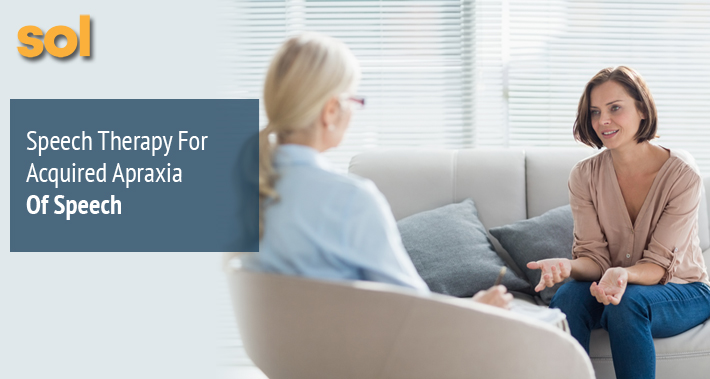
Acquired apraxia of speech is a speech sound disorder caused by an inability to control and coordinate the muscles involved in producing speech.
It results from your brain not being able to properly communicate with speech related muscles.
If you or a loved one have acquired apraxia of speech, it can significantly impact your ability to communicate.
But speech therapy can help.
Speech therapy treatments are geared towards developing the muscles needed for speech and improving your overall speech.
If you’re looking for adult speech therapy services, we’re here to help you address your speech related issues and concerns.
At our speech therapy clinics, we’ll will work with you to tackle your speech challenges and help you free your voice.
On this week’s SLP blog, we’ll take a look at acquired apraxia of speech, and how our team of therapists can help.
What Is Acquired Apraxia Of Speech?
Acquired apraxia of speech is a neurological speech disorder.
It’s the result of traumatic brain injury, particularly to the part of the brain that controls speech and word formation.
RELATED: Speech Therapy For Adults Recovering From Traumatic Brain Injury
This occurs because there is a disruption in communication between your brain and the muscles needed for speech.
Acquired apraxia of speech can leave you unable to coordinate your lips, tongue, and other speech muscles to produce specific letters and sounds.
How To Tell If You Have Acquired Apraxia Of Speech
Acquired apraxia of speech can cause you to have difficulty producing certain speech sounds.
As a result, it’s considered a speech sound disorder.
This can significantly impact your ability to communicate effectively.
There are many various signs of acquired apraxia of speech that can be present, which can range in severity.
General signs and symptoms to look out for include:
- Difficulty making certain speech sounds
- Distorted sounds
- Changed or altered sounds
- Addition or omission of sounds and syllables
- Reduced rate of speech
- Inappropriate and awkward pauses between syllables
- Extended syllable duration
- Having inconsistent pronunciation
- Inability to produce any sounds
How Do You Get Acquired Apraxia Of Speech
Acquired apraxia of speech results from damage to the part of the brain that controls and coordinates speech muscles.
Acquired apraxia of speech can be caused by numerous conditions that can affect and damage the brain.
Some common causes include:
- Traumatic brain injury (TBI)
- Stroke
- Surgical trauma
- Tumor
- Progressive diseases, such as dementia
In some cases, acquired apraxia of speech is the initial, sole, or most notable symptom of certain degenerative diseases.
In this event, it’s referred to as primary progressive apraxia of speech.
How Do Speech Therapists Screen For Acquired Apraxia Of Speech
There aren’t any specific standardized screening procedures for acquired apraxia of speech.
If you’re suspected of having acquired apraxia of speech, a speech therapist will complete a comprehensive assessment.
During the evaluation, they will look to see if there are any issues associated with other neurological conditions.
The evaluation will look at cognitive communication, swallowing issues, and general difficulties with language.
Assessments will also analyze:
- Comorbid conditions, such as dysarthria
- Language and learning limitations
- Social and communication limitations
- Physical and functional impairments
- Other limitations related to quality of life
The assessment will also look at your functional ability to generate speech.
These functional aspects of speech include:
- Comprehensibility
- Efficiency
- Intelligibility
A speech therapist will also look at your motor speech in regards to the symptoms of acquired apraxia of speech previously listed.
How Can Speech Therapists Help With Acquired Apraxia Of Speech
Acquired apraxia of speech is a complex condition that can be caused by numerous causes.
Treatments will depend on the needs of the individual, the severity of the disorder, and the presence of other conditions, such as progressive neurological diseases.
Speech therapy can help you address your communication issues and manage your symptoms.
Let’s take a closer look at some of the treatment options that are available for you.
1. Articulatory Kinematic
Acquired apraxia of speech is a motor speech disorder that affects your ability to coordinate the movements required for speech.
The articulatory kinematic approach works towards training those muscles and improving speech production movements.
This type of treatment involves:
- Developing specific speech movements
- Frequently practicing to improve speech deficiencies
- Utilizing sensory input to teach particular speech movements, (like visual or auditory cues)
- Regularly assessing progress and adapting approaches
This form of therapy can help you produce more articulate sounds and develop your speech motor function.
2. Word And Phrase Focused Approaches
Script training is another approach that can help you improve your communication.
Script training involves repeatedly practicing specific words or phrases that you often use when you need to communicate.
This can help you properly articulate words or phrases that are relevant and more frequently used.
These words and phrases eventually become automatic, and you can begin to use them in conversation relatively easily.
3. Rhythm And Rate Control
Rhythm and rate control can help you improve your ability to produce speech through the use of intonation patterns.
This type of speech therapy is also known as prosodic facilitation approaches.
Speech therapy for rhythm and rate control can include working on and improving the following aspects of speech:
- Rhythmic pacing – controlling your rate of speech
- Contrastive stress – highlighting specific words to better convey meaning
- Melodic intonation – improving melody, stress, and rhythm in speech production
- Metrical pacing – improving patterns of speech by using rhythmic sequences of sounds and tones

4. Sensory Cueing
Sensory cues are used to help you learn particular movement sequences required for speech.
Using external cues can help you better organize and perform the movements needed for speech production.
Tactile cueing, for example, is a method in which a speech therapist will touch your head, neck, or face to correct your speech movement.
This can help you recognize and understand the muscles that need to be activated when producing specific sounds.
Visual cues may also be used, such as hand signs, mirrors, or digital images to demonstrate proper muscle movement and placement when speaking.
Integral stimulation is another cueing method in which you imitate the sound and movements of your speech therapist.
Electropalatography and electromagnetic articulography may also help.
These work by more accurately illustrating how the various muscles in your mouth move when speaking.
Book Your Appointment With Sol Speech And Language Therapy Today
If you or a loved one have, or believe you may have, acquired apraxia of speech, we can help.
Our speech therapists can help identify your issues and work with you to improve your speech and free your voice.
Book your appointment with Sol Speech And Language Therapy today.
6448 E Hwy 290 Suite E-108,
Austin, TX 78723
(512) 368-9488
» https://g.page/r/CfRfhOpEQm7BEAE
Sol Speech & Language Therapy
555 Round Rock W Dr E-221,
Round Rock, TX 78681
(512) 808-3953
» https://g.page/r/Cb5pwCTosSEfEBM
Sol Speech & Language Therapy offers personalized skilled intervention to those struggling with their speech and language skills. Services offered include screening, consultation, and comprehensive evaluation. We also provide one-on-one and/or group therapy for speech sound disorders, receptive/expressive language delay/disorder, stuttering/cluttering, accent reduction, and much more.